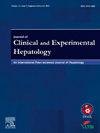Transarterial Chemoembolization: A Consistent and Continuously Evolving Therapy for Hepatocellular Carcinoma
IF 3.3
Q2 GASTROENTEROLOGY & HEPATOLOGY
Journal of Clinical and Experimental Hepatology
Pub Date : 2025-03-03
DOI:10.1016/j.jceh.2025.102538
引用次数: 0
Abstract
Since its introduction in 1977, transarterial chemoembolization (TACE) has widely been accepted treatment for unresectable intermediate stage hepatocellular carcinoma (HCC). Conventional TACE (c-TACE) uses an emulsion of chemotherapeutic agent and ethiodized oil with subsequent embolization of the feeding artery using gelatin sponge. Drug eluting beads (DEB) were introduced in clinical practice in the 2000s and have since been used as an alternative to c-TACE with better outcomes, especially in larger tumors. Considering the widespread use of TACE in HCC, it is important to revisit the current knowledge and the advances that have developed for better safety and efficacy. This article aims to emphasize on the current knowledge and importance of TACE, touch upon the technical aspects including post-TACE care, response assessment, and discontinuation strategies and highlight the recent advances in the technology, catheters, and embolization particles. Thus, despite a rapid change in treatment algorithms and availability of newer drugs for HCC, TACE will remain an integral part of HCC treatment alone or in combination with other therapies.

经动脉化疗栓塞:一种持续发展的肝癌治疗方法
自1977年推出以来,经动脉化疗栓塞(TACE)已被广泛接受用于不可切除的中期肝细胞癌(HCC)的治疗。传统的TACE (c-TACE)使用化疗药物和乙二化油的乳剂,随后使用明胶海绵栓塞供血动脉。药物洗脱珠(DEB)在21世纪初被引入临床实践,并被用作c-TACE的替代品,效果更好,特别是在较大的肿瘤中。考虑到TACE在HCC中的广泛应用,重新审视目前的知识和为提高安全性和有效性而发展的进展是很重要的。本文旨在强调TACE的当前知识和重要性,触及技术方面,包括TACE后护理,反应评估和停药策略,并强调技术,导管和栓塞颗粒的最新进展。因此,尽管HCC的治疗方法和新药的快速变化,TACE仍将是HCC单独或与其他疗法联合治疗的一个组成部分。
本文章由计算机程序翻译,如有差异,请以英文原文为准。
求助全文
约1分钟内获得全文
求助全文
来源期刊

Journal of Clinical and Experimental Hepatology
GASTROENTEROLOGY & HEPATOLOGY-
CiteScore
4.90
自引率
16.70%
发文量
537
审稿时长
64 days
 求助内容:
求助内容: 应助结果提醒方式:
应助结果提醒方式:


